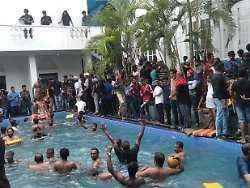shortages and mass protests
Sri Lanka is in chaos
07/10/2022 10:36 am
Sri Lanka has been stuck in a deep economic crisis for months. Again and again there are protests because the people lack the bare essentials. After the presidential palace was stormed, the country’s most powerful men announced their resignations. But the problems are by no means solved.
After the escalation of the protests in Sri Lanka, the country faces an uncertain future. President Gotabaya Rajapaksa fled the capital and announced his resignation after hundreds of protesters stormed his residence. Prime Minister Ranil Wickremesinghe, whose residence was set on fire by angry demonstrators, also offered to resign. The USA called on the political leadership in Sri Lanka to bring about a return to economic stability as soon as possible.
According to information from security circles, security forces were able to bring the head of state to safety on Saturday shortly before the presidential palace was stormed. Later, Speaker of Parliament Mahinda Abeywardana announced that Rajapaksa had agreed to step down next Wednesday. After fleeing his residence, the head of state was taken to a naval ship heading for territorial waters south of the island.
Prime Minister Wickremesinghe also wants to go
Prime Minister Wickremesinghe, who would take over the president’s duties if the president were to resign, offered his resignation at a special government meeting with opposition politicians. In order to “ensure the security of the citizens”, Wickremesinghe is ready to clear the way for a new unity government, his office said.
However, he was apparently unable to calm the anger of the demonstrators: In the afternoon, a crowd also entered Wickremesinghe’s private residence and set it on fire, as the Prime Minister’s office announced. Pictures on online networks showed a crowd cheering the fire.
The USA are addressing Sri Lanka in no uncertain terms
The US called for a de-escalation of the situation. “We urge this government, or any new constitutionally elected government, to find and implement solutions expeditiously to achieve long-term economic stability,” a US State Department spokesman said Sunday.
The political leadership must react to the “dissatisfaction” of the citizens in view of the economic crisis and the electricity, food and fuel shortages. The ministry spokesman called on parliament to “devote itself to the well-being of the nation – and not to a specific political party”.
In distress for weeks
Mass protests have been going on in Sri Lanka for weeks because of the catastrophic economic situation. According to the police, hundreds of thousands of people had gathered at Rajapaksa’s official residence on Saturday morning. Television footage showed hundreds of them climbing over the fence of the presidential palace. Soldiers fired into the air to push the crowd back until Rajapaksa was safe, according to defense sources.
The demonstrators then strolled through the palace relatively unhindered. Live video on online networks showed some splashing in the President’s swimming pool. People also broke into the nearby presidential office, in front of which demonstrators have been camping for three months.
The curfew imposed did not help
The authorities had imposed a curfew on Friday to prevent the protests on Saturday. However, after pressure from opposition parties, lawyers and human rights activists, the order was lifted. She had been largely ignored by the demonstrators anyway. Around 20,000 soldiers and police officers were sent to Colombo to protect the President, according to the authorities.
Three people were hospitalized with gunshot wounds in Colombo’s main hospital. According to the hospital, 36 others were treated for breathing difficulties after the use of tear gas.
Because of the severe economic crisis, the government is no longer able to finance the most important imports such as food, fuel and medicines. Meanwhile, Sri Lanka has asked the International Monetary Fund (IMF) and Russia for help.
Mass protests against the government escalated for the first time in May. Nine people were killed and hundreds more injured. The government of Mahnda Rajapaksa then resigned. The brother of the resigning head of government, President Gotabaya Rajapaksa, remained in office.
A major trigger of the worst economic crisis since the South Asian country gained independence in 1948 was the slump in international tourism as a result of the corona pandemic. The government was also accused of mismanagement.
